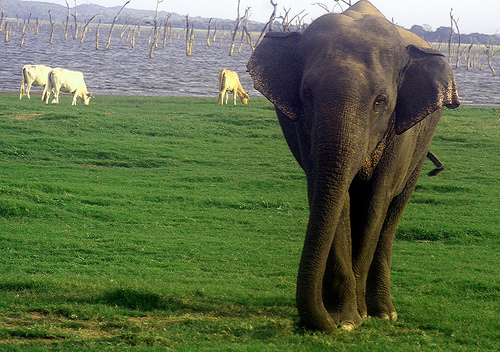 |
Home About Directory Conservation |
 |
Kaudulla Tank Location: 80 12’ 0 N and 800 52’ 30 E to 80 6’ 0 N and 800 58 30 E; 906411 N and 485314 E to 895353 N and 496328 E; approximately 190km from Colombo, in the Polonnaruwa District, of the North-central Province. Area: The tank area is 6,675 ha. Altitude: Information not available Overview: Kaudulla is an ancient irrigation tank constructed in the 3rd century AD during the reign of King Mahasen. The tank was subsequently abandoned, but it was restored in 1959 by the Irrigation Department. It is now a part of system D of the Mahaweli Network and receives water through the Elahera anicut. The tank and its surroundings were declared as the Kaudulla National Park in 2002. The National Park supports a large bird population and together with Minneriya and Giritale has been identified as an IBA by BirdLife International. Physical features: The tank has a gross catchment area of 97 sq. miles. Gal Oya and Aluth Oya are the two main streams feeding the reservoir, while floodwaters from the Minneriya tank are also discharged to Kaudulla. The water in the reservoir is known to have a pH of 7.23-8.56. Kaudulla is located in the dry zone of Sri Lanka and is influenced by the northeast monsoon from October to February. It receives an annual rainfall of 1,500 – 2,000 mm, and has a mean annual temperature of 280C. Ecological features: The area surrounding the tank consists of tropical dry mixed evergreen forests, abandoned chena cultivations, and grasslands. The phytoplankton community in the tank is dominated by the blue green algae Microcystis sp. and the filamentous diatom Melosira sp. 24 species of mammals, 25 species of reptiles, 26 species of fish, and 160 species of birds have been recorded from the National Park. Noteworthy fauna: The freshwater fish in the tank is dominated by the exotic Oreochromis mossambicus. Among the amphibians, Rana gracilis is endemic. Noteworthy reptiles include the freshwater turtles Lissemys punctata and Melanochelys trijuga. Large water birds include Pelecanus philippensis and Leptoptilos javanicus. The tank caters to the water requirements of wild animals in the Park, including a large herd of Elephas maximus. Noteworthy flora: Trees such as Manilkara hexandra, Chloroxylon swietenia and Vitex altissima, are some of the predominant species occurring in the forests bordering the tank. Some areas are dominated by shrubs such as Randia 119 dumetorum and Calotropis giganteam and exotic grasses such as Imperata cylindrica and Panicum maximum. Land use: The water body is used for fisheries activities while surrounding areas are either set aside for wildlife conservation or used for agriculture. Possible changes in land use: Expansion of chena cultivation into the tank catchment area. Hydrological and biophysical values: The reservoir provides water for irrigation of agricultural lands in surrounding areas. Additionally, it acts as a flood detention mechanism during the rainy season and as such two-thirds of the Kaudulla National Park is inundated for several months of the year. Social and cultural values: The reservoir was built by the sister of King Mahasen, who built the neighbouring Minneriya reservoir. It supports subsistence-fishing activities of local communities and provides water for agriculture. Scientific research and monitoring: A water management study was carried out within the Kaudulla irrigation system in 1980. Conservation education: The DWC has conducted awareness programmes through the electronic media. Recreation and tourism: The park is visited by wildlife enthusiasts to view birds and elephants. Locals operate catamaran rides to view wildlife and a private safari camp is located at the park border. However, there is a lack of visitor facilities such as bungalows within the park. Conservation measures taken: The tank and surrounding areas were declared as a National Park under the FFPO in 2002. In 2004, the Kaudulla-Minneriya Jungle Corridor was declared a National Reserve to link Kaudulla with the Minneriya National Park. In 1997 the Forest Department conducted a reforestation programme that created a 50 acre teak forest. Conservation measures proposed: Information not available Disturbance and threats: Cattle grazing causes habitat modification and degradation while the spread of invasive alien species such as Lantana camara is also causing serious problems to wildlife habitats around the tank. Land tenure: State owned Management authority and jurisdication: The National Park is under the authority of the DWC, while the reservoir and irrigation system is maintained by the Irrigation Department. References: BirdLife International (2005); DWLC (2004); Gunasekera (1997); Silva (2003); University of Sterling/ University of Peradeniya (1998) |
| Maps |